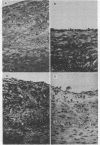Abstract
We tested the hypothesis that loss of endothelium results in increased transport of lipoprotein into the arterial wall, favors accumulation of lipid, and thus predisposes to atherosclerosis. In rabbits initially fed a diet low in lipid, the aortas were de-endothlialized with an intraarterial balloon catheter; 28 days later, the animals were divided into two groups. Group I animals were continued on a diet low in lipid and sacrificed at 8, 11, 13, and 15 weeks after de-endothelialization. Group II animals were fed the same diet supplemented with 0.5% cholesterol and sacrificed at comparable intervals. Aortas of group I animals revealed proliferative fibromuscular intimal thickening in both de-endothelialized and re-endothelialized areas, with little or no fatty change in the intima. In contrast, aortas of group II animals revealed slight to marked fatty change in the intima, characterized by accumulation of oil red O-positive material with anisotropic lipid inclusions. The greatest quantity of lipid was present in intimal thickening beneath regenerated endothelium, and not in adjacent intimal thickening lacking an endothelial lining. These results do not support the hypothesis that the absence of endothelium favors accumulation of lipid and predisposes to atherosclerosis. The experiments indicate that lipid accumulates preferentially in areas of intimal thickening covered by regenerated endothelium.
Full text
PDF




Images in this article
Selected References
These references are in PubMed. This may not be the complete list of references from this article.
- Fisher-Dzoga K., Chen R., Wissler R. W. Effects of serum lipoproteins on the morphology, growth, and metabolism of arterial smooth muscle cells. Adv Exp Med Biol. 1974;43(0):299–311. doi: 10.1007/978-1-4684-3243-5_15. [DOI] [PubMed] [Google Scholar]
- French J. E. Atherosclerosis in relation to the structure and function of the arterial intima, with special reference to th endothelium. Int Rev Exp Pathol. 1966;5:253–353. [PubMed] [Google Scholar]
- Hardin N. J., Minick C. R., Murphy G. E. Experimental induction of atheroarteriosclerosis by the synergy of allergic injury to arteries and lipid-rich diet. 3. The role of earlier acquired fibromuscular intimal thickening in the pathogenesis of later developing atherosclerosis. Am J Pathol. 1973 Nov;73(2):301–326. [PMC free article] [PubMed] [Google Scholar]
- Harker L. A., Slichter S. J., Scott C. R., Ross R. Homocystinemia. Vascular injury and arterial thrombosis. N Engl J Med. 1974 Sep 12;291(11):537–543. doi: 10.1056/NEJM197409122911101. [DOI] [PubMed] [Google Scholar]
- Hata Y., Hower J., Insull W., Jr Cholesteryl ester-rich inclusions from human aortic fatty streak and fibrous plaque lesions of atherosclerosis. I. Crystalline properties, size and internal structure. Am J Pathol. 1974 Jun;75(3):423–456. [PMC free article] [PubMed] [Google Scholar]
- LEVINE J. B., ZAK B. AUTOMATED DETERMINATION OF SERUM TOTAL CHOLESTEROL. Clin Chim Acta. 1964 Oct;10:381–384. doi: 10.1016/0009-8981(64)90073-7. [DOI] [PubMed] [Google Scholar]
- Minick C. R., Murphy G. E., Campbell W. G., Jr Experimental induction of athero-arteriosclerosis by the synergy of allergic injury to arteries and lipid-rich diet. I. Effect of repeated injections of horse serum in rabbits fed a dietary cholesterol supplement. J Exp Med. 1966 Oct 1;124(4):635–652. doi: 10.1084/jem.124.4.635. [DOI] [PMC free article] [PubMed] [Google Scholar]
- Minick C. R., Murphy G. E. Experimental induction of atheroarteriosclerosis by the synergy of allergic injury to arteries and lipid-rich diet. II. Effect of repeatedly injected foreign protein in rabbits fed a lipid-rich, cholesterol-poor diet. Am J Pathol. 1973 Nov;73(2):265–300. [PMC free article] [PubMed] [Google Scholar]
- Ross R., Glomset J. A. Atherosclerosis and the arterial smooth muscle cell: Proliferation of smooth muscle is a key event in the genesis of the lesions of atherosclerosis. Science. 1973 Jun 29;180(4093):1332–1339. doi: 10.1126/science.180.4093.1332. [DOI] [PubMed] [Google Scholar]
- Ross R., Glomset J. A. The pathogenesis of atherosclerosis (second of two parts). N Engl J Med. 1976 Aug 19;295(8):420–425. doi: 10.1056/NEJM197608192950805. [DOI] [PubMed] [Google Scholar]
- Ross R., Glomset J., Kariya B., Harker L. A platelet-dependent serum factor that stimulates the proliferation of arterial smooth muscle cells in vitro. Proc Natl Acad Sci U S A. 1974 Apr;71(4):1207–1210. doi: 10.1073/pnas.71.4.1207. [DOI] [PMC free article] [PubMed] [Google Scholar]
- Ross R., Harker L. Hyperlipidemia and atherosclerosis. Science. 1976 Sep 17;193(4258):1094–1100. doi: 10.1126/science.822515. [DOI] [PubMed] [Google Scholar]
- Stemerman M. B., Ross R. Experimental arteriosclerosis. I. Fibrous plaque formation in primates, an electron microscope study. J Exp Med. 1972 Oct 1;136(4):769–789. doi: 10.1084/jem.136.4.769. [DOI] [PMC free article] [PubMed] [Google Scholar]




